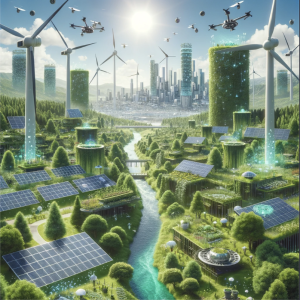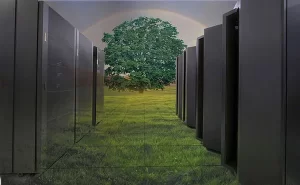
AI can be a powerful ally in tackling numerous global challenges we face today. While critics often point out the energy consumption of AI systems, it’s important to consider this in the broader context of global carbon emissions. The Environmental Protection Agency states that major sources of these emissions include agriculture, which accounts for 24% of the total, manufacturing contributing 21%, electricity at 25%, and transportation at 14%. Meanwhile, the added precision that AI brings to resource management can revolutionize these industries. It could reduce inefficiencies and minimize waste, contributing to a more sustainable approach. This perspective suggests that our efforts should be directed towards optimizing these sectors using AI, rather than focusing solely on the energy consumption of AI itself and thereby halting its development. Let’s see how AI helps optimize these sectors.
Agriculture
In agriculture, AI makes it possible to manage resources more effectively through precision agriculture, guaranteeing that crops precisely receive the right amounts of inputs like water, fertilizer, and pesticides. This accuracy not only reduces resource waste but also increases crop yields, which greatly lowers the sector’s environmental effect. Real-time analyses of variables like crop health, weather patterns, and soil quality are performed by AI systems’ algorithms. AI can also predict crop yields, which helps optimize planning and distribution, thus reducing waste and ensuring better market prices. Further, AI can be used to monitor crop health, soil quality and pest infestations, thereby also reducing waste. Additionally, AI can also analyze weather data to predict environmental conditions, helping farmers make calculated decisions about the optimal times to plant or harvest their crops.

Manufacturing
In the manufacturing sector, AI reduces waste by enabling smarter production processes. By adjusting production schedules, avoiding overproduction, and reducing production errors. Within the supply chain sector, AI is used to improve logistics, lower transportation costs, and shorten processing delays for waste management. Through predictive analytics AI can foresee changes in demand and dynamically modify inventory levels, averting overstock scenarios that frequently result in waste. Thus, AI makes inventory management easier and lowers the risk of food waste and deterioration during storage and transit. Furthermore, Smart AI systems can control the energy consumption of the manufacturing process, reducing the overall carbon footprint of these factories. Besides just production efficiency, AI can also help to design products that are easier to recycle and have less environmental impact over their lifecycle.
Waste management
Furthermore, AI is also used in the waste management and recycling industry. For example, AI-powered sensors are installed in waste bins to monitor the waste levels in real time. This data helps optimize waste collection routes, ensuring that collection trucks are deployed only when bins are full, reducing unnecessary pickups and the associated fuel consumption. Expanding on this, AI can be used to predict patterns in waste generation of different urban areas, allowing for even more efficient waste collection strategies. Besides just waste collection, AI can also help identify efficient methods for recycling different materials, reducing the amount of waste that ends up being sent to landfills and its associated carbon emissions.

Sorting and recycling
Additionally, in the sorting and recycling facilities, the cost and complexity of implementing AI can be mitigated through innovative AI solutions that we, as AI experts, can contribute to. The automation of separating recyclables from general garbage using robotics and computer vision systems increases recycling rates and decreases pollution. AI also plays a critical role in optimizing landfill operations, using predictive analytics to minimize environmental effects and extend landfill longevity. Also, AI can be used to identify and sort different types of plastic, which is currently a huge global issue.
Transportation
In the transportation sector, despite worries about the reliability and security of AI systems, artificial intelligence significantly contributes by controlling traffic flow, encouraging sustainable transportation, and optimizing routes, all of which lower fuel consumption and carbon emissions. Here we, as AI experts, can play a huge role in addressing such concerns by enhancing the security and reliability of AI systems in transportation. Also, AI can be used to improve routing in public transportation, allowing for more efficient routes and schedules which can drastically reduce emissions. In the electric vehicle space, AI can be utilized to optimize battery performance and charging infrastructure.

Conclusion
To address the issue of AI’s own climate impact, companies are actively seeking ways to diminish AI’s carbon footprint, especially since certain government regulations and taxes are directly proportional to the total emissions a firm generates through its use of AI. Training an AI model is energy-intensive, and it is projected that by 2040, it will require 14% of the total carbon emissions. However, AI could play a undeniable role in reducing the emissions of all other industries, therefore resulting in a net reduction of carbon emissions.
Nowadays, research on renewable energy is receiving funding from several tech businesses. They try to lower their electricity expenses while also working toward the long-term objective of reducing their environmental impact. These investments would not have happened if AI would not be used. The research is likely to benefit other actors as well and not just the tech companies themselves, as we could find better ways to use renewable energy resources. From energy-efficient hardware designs to innovative data center solutions, these advancements showcase the industry’s commitment to finding sustainable pathways for AI development. It is safe to say that all the positives and optimizations AI brings outweigh the negatives of increasing carbon emissions. At the same time, it is a very good thing that many companies are very concerned with AI’s total current consumption of energy and are actively searching for sustainable solutions.
So while AI surely has its carbon footprint, its role in optimizing other industries will more than make up for it. We as AI experts should therefore focus on improving these sectors, as this not only promises considerable financial returns, but also revolutionizes these sectors, leaving a positive impact on the climate in doing so. A true win-win scenario.


